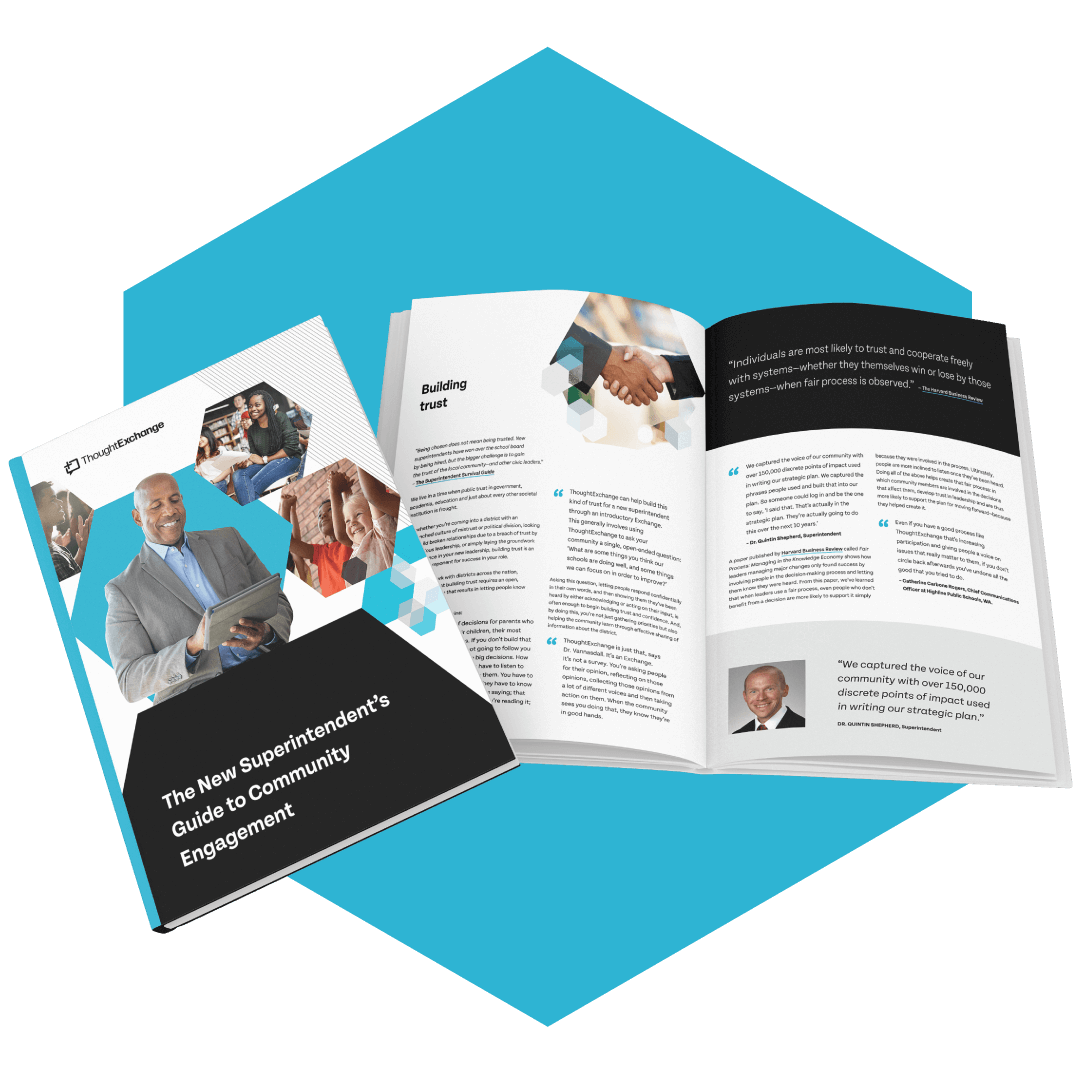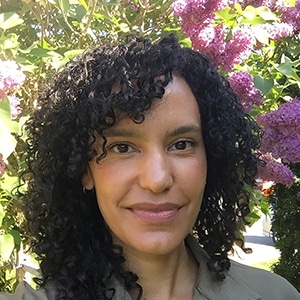







Choosing The Right Community Engagement Software
You know you need to tap into your community’s voice to win at community engagement. But whether you’re building your strategy or nailing down your plan, the right tech will make things easier. Comprehensive community engagement software gets you from insights to action faster, engaging thousands of community members while tackling your district’s most critical issues.
Here’s what you need to know about community engagement software.
In this Article
- What is community engagement software?
- Why you need community engagement software
- How to choose the right community engagement software
- Types of community engagement software—pros and cons
- 3 features your community engagement software must have
- Solve your district’s most pressing issues with ThoughtExchange
What is community engagement software?
Community engagement software is a tool for streamlining your community engagement initiatives. It allows education leaders to gather feedback and get alignment from tens, hundreds, or even thousands of people in just days. It also facilitates candid, collaborative community conversations that help districts realize their goals.
Whether you’re working on a strategy or plan, performance, or culture, a community engagement platform will help you achieve your goals more quickly.
A comprehensive community engagement platform like ThoughtExchange will allow you to integrate your strategy with your community and take decisive, supported action in less time. It provides planning, scheduling, and analysis tools to help you quickly set strategy and monitor execution.
Why you need community engagement software
An engaged community means increased trust, buy-in, and ownership. It empowers education leaders to make more effective decisions for their districts with their community’s insights and support. A comprehensive community engagement platform will help you access your community efficiently and effectively.
With so much riding on community support for district projects and funding, education leaders need a platform that will get them better participation and more nuanced data.
Community engagement software lets you get input from hundreds or thousands of people. Use it to:
- Get more people on board with bonds and levies
- Save weeks on your LCAP surveys and data-crunching
- Make budget decisions the community supports
- Find common ground on divisive issues
Consult more people in an inclusive, anti-biased environment. Drastically cut back on the time and resources you spend on town halls and meetings, and reach your district’s goals.
How to choose the right community engagement software
Types of community engagement software—pros and cons
Pros
Cons
- Easy to set up
- Easy to participate in
- Quick answer to simple question
- Engages large groups
- Surface-level data—no insight into why participants respond a certain way
- Answers are pre-selected and subject to bias
- Can’t measure response intensity or sentiment
- Free for up to 100 participants
- Open forum for discussion (particularly for smaller groups)
- Can’t be scaled and still maintain quality of conversation
- Zoom fatigue
- Paid plans for over 100 participants
- Requires note-taking and recording for later analysis
- Requires time off work or parenting to participate
- Easy to set up
- Easy to participate in
- Quick answers to simple questions
- Engages large groups Offers quantitative and qualitative question options
- Surface-level data—no insight into why participants respond a certain way
- Answers to close-ended questions are pre-selected and subject to bias
- Answers to open-ended questions must be manually analyzed
- Usually just the first step in engagement, followed by weeks of focus groups and data analysis
- Easy to set up an Exchange using templates
- Easy to participate in from any device at any time
- Scales easily from 10 to 10,000+ participants
- Offers quantitative survey questions
- Ask one open-ended question to get thousands of quality responses
- Access people’s real thoughts and insights instead of predetermined answers
- Anti-bias technology ensures participants and leaders engage ideas on merit, not on who’s sharing them
- Built-in AI analytics provide rich data as the conversation unfolds AI and manual data analysis is done in minutes or hours instead of weeks
- Easy to export reports, presentations, and HTML pages for sharing results with participants and leadership
- Leaders can’t control participant responses
- Requires trust and transparency from leaders
- Costs are up front, but saves immense time and money in the long run
Three features your community engagement software needs to have
Whatever community engagement software you go with, you’ll want to make sure it has the following features:
- Open-ended questions with ratings: Get the most accurate data from your group.
- Themes: Quickly sort participant responses by keyword or sentiment, or create custom themes with an intuitive manual theming tool. Understand qualitative data through a quantitative lens with AI theming.
- Differences: Identify common ground among polarized groups so you base your decisions on data everyone supports.
Here’s how three of our education partners use these features to engage their communities more effectively.
Woodland D50 uses open-ended questions to get district better data
As the pandemic took its toll on Woodland School District 50 in Lake County, IL, Superintendent Dr. Lori Casey, Communications Manager Brooke Hagstrom, and the Board of Education knew that parent and caregiver feedback would be key to making it through COVID-19.
After using a survey and focus groups to plan their hybrid remote learning strategy for the 2020/2021 school year, some parents complained that the survey didn’t ask the right questions and the focus groups weren’t tapping into a wide enough range of insights.
So Dr. Casey and Hagstrom used ThoughtExchange, leveraging open-ended questions so parents could share their children’s specific needs instead of voting on predetermined options.
They asked:
To help with our planning efforts for next year, please consider the following question: As we wrap up this very unique school year, what do you want us to know about your child’s learning experience?
Surveys invite participants to share one-way feedback, providing surface-level data. But ThoughtExchange leverages your community’s collective intelligence in an interactive conversation, giving you nuanced insights and elevated data. With ThoughtExchange, you don’t just ask—you listen. And your participants listen to each other, too.
"[With traditional surveys], we spent so much time trying to figure out the correct wording, and there were all these different interpretations of why it wasn't asking the right questions. [But] ThoughtExchange helps us be proactive and move our communications forward.”
- Brooke Hagstrom, Communications Manager, Woodland School District 50Blue Valley uses Themes to get qualitative data through a quantitative lens
Blue Valley Schools encompasses 91 square miles in southeastern Johnson County, Kansas, serving 23,000 students in total. Students identify 90 different languages as their primary home language.
Blue Valley strives to support its community in communication, academics, and social-emotional well-being. But, as Kristi McNerlin, Chief Communications Officer, says, support begins with hearing what the community has to say. “Sometimes leaders want black-and-white data—How many people answered this or that?— but sometimes it’s more about how people feel versus quantitative data from a limited number of survey choices,” says McNerlin.
"With ThoughtExchange, people really feel strongly about their ability to voice where they're coming from. That's the difference between ThoughtExchange and a standard survey. Participants really feel like they can share their thoughts."
- Kristi McNerlin, Chief Communications Officer, Blue Valley SchoolsDifferences helps Union Public Schools build consensus for controversial mascot change
In 2020, Union Public Schools proposed a change to their mascot. “We felt like [the mascot] no longer matched our core values,” Chris Payne, Chief Communications Officer, says. Eight core values guide Union Public Schools, and the previous mascot violated three of them:
- Inclusiveness, cultivating an organizational culture of accepting children, families, and employees for who they are rather than categorizing them by income, ethnicity, or ability;
- Collegiality, demonstrating respect and an ability to work as team members;
- and Empowerment, helping people reach their full potential.
Knowing they’d need their community’s input to succeed, they used ThoughtExhange.
Payne was worried about the conversation becoming divisive, but ThoughtExchange’s anti-bias technology and anonymous rating system ensured the mascot change didn’t become a contentious issue.
Payne used ThoughtExchange’s Differences tool to analyze and compare groups of polarizing ratings to understand where people agree and disagree so that the district could make sure there was consensus on the final mascot.
“[Differences] helped me see where we clearly had consensus and where there were divergent, polarizing opinions. Even in the ratings of other people's opinions, we very quickly saw where we had agreement and where we didn't. It’s a great tool for building consensus.”
- Chris Payne, Chief Communications Officer, Union Public SchoolsSolve your district’s most pressing issues with ThoughtExchange
“Using ThoughtExchange with our staff and community on a quarterly basis keeps us accountable, transparent, and consistent. People can expect an Exchange every quarter, and we can take their feedback to district leaders and challenge ourselves to continuously improve.”
– Dr. Lori Casey, Superintendent, Woodland School District 50




